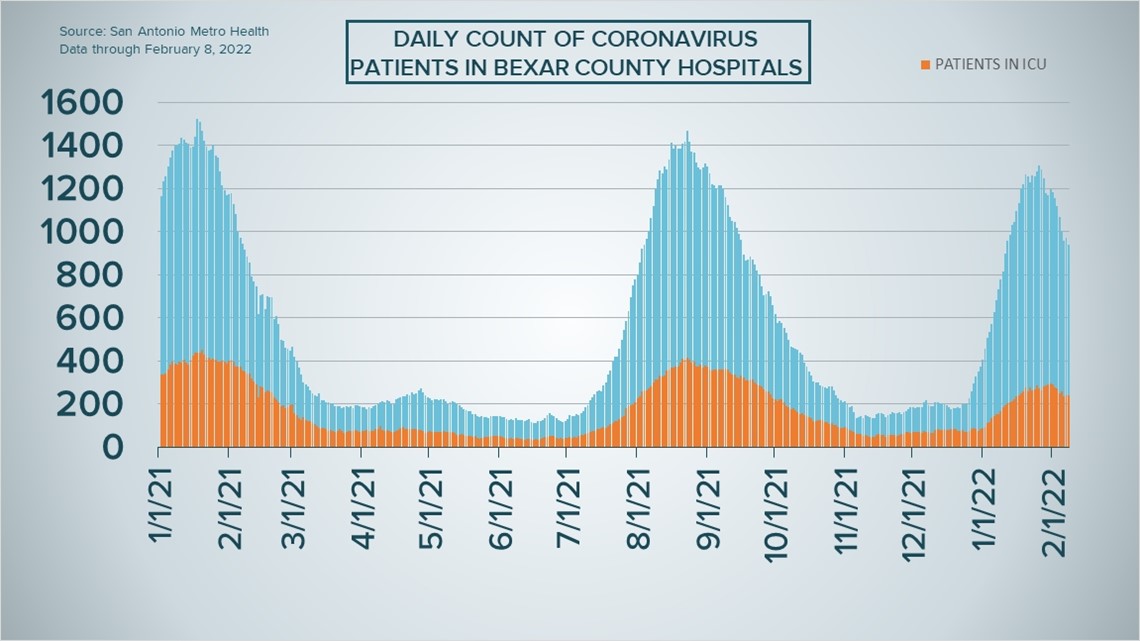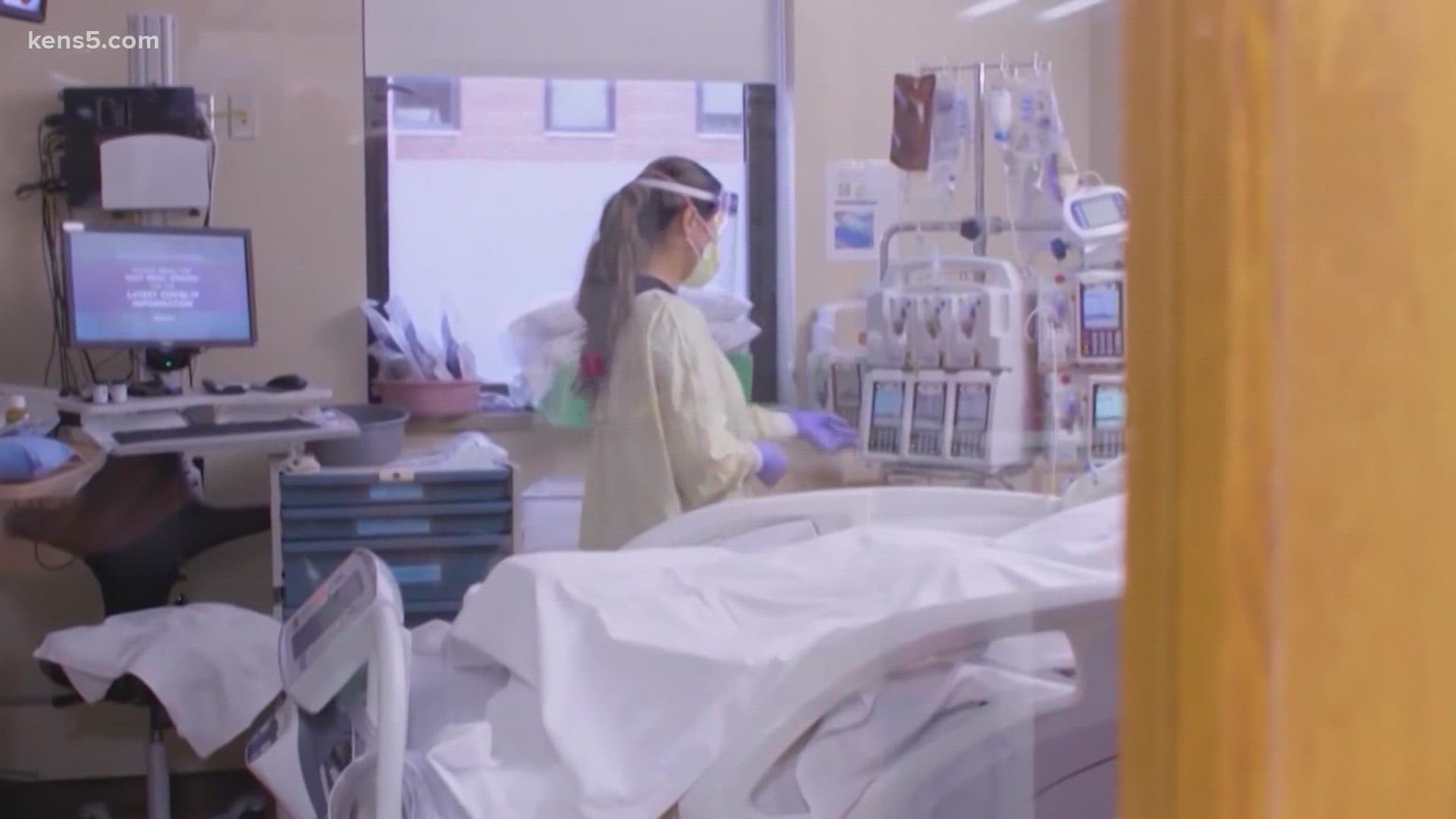SAN ANTONIO — The latest data from Bexar County health authorities continue to show that the omicron variant may be loosening its grip on the community, as Metro Health reported fewer than 1,000 new cases (986) for the first time all year.
That comes after a January that averaged more than 4,700 new coronavirus diagnoses a day, resulting in some of the highest case totals the San Antonio area has seen since the pandemic started two years ago. By comparison, February has averaged less than half of January's number for new daily cases.
This month's downward trend has resulted in the lowest seven-day daily case average since Jan. 2; the number stood at 1,761 on Monday. The positivity rate has also dropped to 25.1%, which is a decrease of 7.8 percentage points from last week.
Meanwhile, six additional virus-related deaths were also reported by Metro Health on Monday, while local hospitalizations dropped to 937. January 11 was the last time there were that few patients receiving treatment in local hospitals.
Of those 937 patients, 241 are in intensive care and 116 are on ventilators.
More than 510,000 Bexar County residents have been diagnosed with COVID-19, while 5,165 have passed away from complications with the virus.
On the national front, a San Antonio-based doctor recently testified to Congress about long-term-COVID effects, suggesting that it may soon lead to millions of Americans requesting disability benefits.
The Alamodome is continuing to host no-cost COVID-testing every day until Feb. 21. And here's which local pharmacies may still have free N95 masks for the public.
How Bexar County is trending




Vaccine Progress in Bexar County
The following numbers are provided by San Antonio Metro Health. A full breakdown can be found here.
- 1.732 million eligible Bexar County residents have received at least one dose of the coronavirus vaccine as of Thursday, Feb. 3.
- 1.406 million eligible Bexar County residents are fully vaccinated as of Thursday, Feb. 3.
The CDC states that "when a high percentage of the community is immune to a disease (through vaccination and/or prior illness)," that community will have reached herd immunity, "making the spread of this disease from person to person unlikely."
The City of San Antonio breaks down the vaccination rates by zip code on Metro Health's Vaccination Statistics page.
Coronavirus in Texas
The total number of coronavirus cases in the state since the pandemic began grew by 11,753 on Tuesday, according to the Texas Department of State Health Services. That total includes 8,801 new confirmed cases and 2,952 new probable cases. More details can be found on this page.
Tuesday's figures bring the total number of Texans diagnosed with COVID-19 to more than 6.395 million.
An additional 282 Texans have died from virus complications, meanwhile, raising the statewide death toll to 79,711.
Coronavirus symptoms
The symptoms of coronavirus can be similar to the flu or a bad cold. Symptoms include fever or chills, cough, shortness of breath or difficulty breathing, fatigue, muscle or body aches, headache, new loss of taste or smell sore throat, congestion or runny nose, nausea or vomiting, and diarrhea, according to the Centers for Disease Control.
Most healthy people will have mild symptoms. A study of more than 72,000 patients by the Centers for Disease Control in China showed 80 percent of the cases there were mild.
But infections can cause pneumonia, severe acute respiratory syndrome, kidney failure, and even death, according to the World Health Organization. Older people with underlying health conditions are most at risk.
Experts determined there was consistent evidence these conditions increase a person's risk, regardless of age:
- Chronic kidney disease
- COPD (chronic obstructive pulmonary disease)
- Obesity (BMI of 30 or higher)
- Immunocompromised state (weakened immune system) from solid organ transplant
- Serious heart conditions, such as heart failure, coronary artery disease, or cardiomyopathies
- Sickle cell disease
- Type 2 diabetes
- The CDC believes symptoms may appear anywhere from two to 14 days after being exposed.
Human coronaviruses are usually spread...
- Between people who are in close contact with one another (within about 6 feet).
- Through respiratory droplets produced when an infected person coughs, sneezes or talks. These droplets can land in the mouths or noses of people who are nearby or possibly be inhaled into the lungs.
- Some recent studies have suggested that COVID-19 may be spread by people who are not showing symptoms.
Help stop the spread of coronavirus
- Stay home when you are sick.
- Eat and sleep separately from your family members
- Use different utensils and dishes
- Cover your cough or sneeze with your arm, not your hand.
- If you use a tissue, throw it in the trash.
Find a Testing Location
City officials recommend getting a COVID-19 test if you experience fever or chills, cough, shortness of breath or difficulty breathing, fatigue, muscle or body aches, headache, new loss of taste or smell, sore throat, congestion or runny nose, nausea or vomiting, or diarrhea.
Here's a Testing Sites Locator to help you find the testing location closest to you in San Antonio.
Latest Coronavirus Headlines
- No, the alpha and beta variants of COVID-19 aren’t circulating in the US
- 'We failed on the social science': US reaches 900,000 COVID-19 deaths
- No, a scientific study doesn't say you can smoke marijuana to prevent COVID-19
- Olympic athletes have new anxiety: testing negative for COVID
- Sweden is the latest European country to end COVID restrictions
- Long COVID: Why does it happen? Who does it normally effect?

